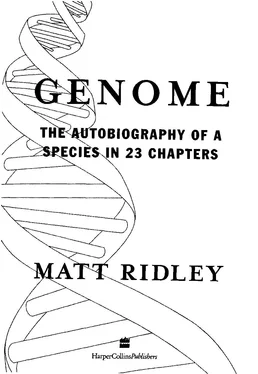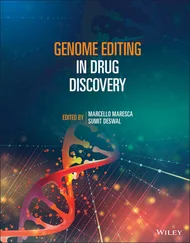Genome - Matt Ridley
Здесь есть возможность читать онлайн «Genome - Matt Ridley» — ознакомительный отрывок электронной книги совершенно бесплатно, а после прочтения отрывка купить полную версию. В некоторых случаях можно слушать аудио, скачать через торрент в формате fb2 и присутствует краткое содержание. Жанр: Старинная литература, на английском языке. Описание произведения, (предисловие) а так же отзывы посетителей доступны на портале библиотеки ЛибКат.
- Название:Matt Ridley
- Автор:
- Жанр:
- Год:неизвестен
- ISBN:нет данных
- Рейтинг книги:5 / 5. Голосов: 1
-
Избранное:Добавить в избранное
- Отзывы:
-
Ваша оценка:
- 100
- 1
- 2
- 3
- 4
- 5
Matt Ridley: краткое содержание, описание и аннотация
Предлагаем к чтению аннотацию, описание, краткое содержание или предисловие (зависит от того, что написал сам автор книги «Matt Ridley»). Если вы не нашли необходимую информацию о книге — напишите в комментариях, мы постараемся отыскать её.
Matt Ridley — читать онлайн ознакомительный отрывок
Ниже представлен текст книги, разбитый по страницам. Система сохранения места последней прочитанной страницы, позволяет с удобством читать онлайн бесплатно книгу «Matt Ridley», без необходимости каждый раз заново искать на чём Вы остановились. Поставьте закладку, и сможете в любой момент перейти на страницу, на которой закончили чтение.
Интервал:
Закладка:
known — with delicate contradiction — as the Roundish Flat Worm, or RFW. It was probably just one of many rival body plans, but its descendants inherited the earth or large chunks thereof. Was it the best design, or just the most brilliantly marketed? Who was the Apple of the Cambrian explosion and who the Microsoft?
Let us take a closer look at one of the Hox genes on human chromosome 12. Hox C4 is the genetic equivalent of a gene called dfd in flies, which is expressed in what will become the mouthparts of the adult fly. It is also very close in sequence to its counterparts on other chromosomes, A4, B4 and D4 - and the mouse versions of the same genes: a 4, b4, c4 and d4. In the embryo of a mouse, these genes are expressed in the part that will become the neck: the cervical vertebrae and the spinal cord within them. If you 'knock out' one of these genes by mutation, you find that one or two of the vertebrae of the mouse's neck are affected. But the effect of the knock-out is very specific. It makes the affected vertebrae grow as if they were further forward in the mouse's neck than they are. The Hox 4 genes are needed to make each neck vertebra different from the first neck vertebra. If you knock out two of the Hox 4 genes, more vertebrae are affected, and if you knock out three of the four genes, even more cervical vertebrae are affected. Therefore, the four genes seem to have a sort of cumulative effect. Moving from head to rear, the genes are switched on one after another and each new gene turns that part of the embryo into a more posterior body part. By having four versions of each Hox gene, we and mice have rather more subtle control over the development of our bodies than flies do with just one Hox cluster.
It also becomes clear why we have up to thirteen Hox genes in each cluster rather than eight, as flies do. Vertebrates have post-anal tails, that is spines which go on well past their anuses. Insects do not. The extra Hox genes that mice and people have, which flies do not, are needed for programming the development of the lower back and tail. Since our ancestors, when they became apes, shrank their tails to nothing, these genes are presumably somewhat silent in us compared with their equivalents in mice.
l 8 2 G E N O M E
We are now in a position to face a vital question. Why are the Hox genes laid end-to-end, with the first genes expressed at the head of the animal, in every species so far investigated? There is as yet no definitive answer, but there is an intriguing hint. The foremost gene to be expressed is not only expressed in the foremost part of the body; it is also the first to be expressed. All animals develop from the bow to the stern. So the co-linear expression of the Hox genes follows a temporal sequence, and it is probable that the switching on of each Hox gene somehow switches on the next one in line or allows it to be opened up and read. Moreover, the same is probably true of the animal's evolutionary history. Our ancestors seem to have grown more complicated bodies by lengthening and developing the rear end, not the head end. So the Hox genes replay an ancient evolutionary sequence. In Ernst Haeckel's famous phrase,
'ontogeny recapitulates phylogeny'. The embryo's development occurs in the same sequence as its ancestors' evolution.7
Neat as these tales are, they tell only a fraction of the story. We have given the embryo a pattern - a top—down asymmetry and a bow-stern asymmetry. We have given it a set of genes that get turned on according to a clever sequence of timing and thus are each expressed in a different part of the body. Each Hox compartment has switched on its special Hox gene, which in turn has switched on other genes. The compartment must now differentiate in the appropriate way. It must, for example, grow a limb. The clever part of what happens next is that the same signals are now used to mean different things in different parts of the body. Each compartment knows its location and identity and reacts to the signals accordingly.
Our old friend decapentaplegic is one of the triggers for the development of a leg in one compartment of a fly and a wing in another.
It in turn is triggered by another gene called hedgehog, whose job is to interfere with the proteins that keep decapentaplegic silenced and thus to awaken it. Hedgehog is a so-called segment-polarity gene, which means it is expressed in every segment, but only in the rear half thereof. So if you move a hedgehog -expressing piece of tissue into the anterior half of the wing segment, you get a fly with a sort S E L F - A S S E M B L Y 1 8 3
of mirror-image wing with two front halves fused back to back in the middle and two back halves on the outsides.
It will not surprise you to learn that hedgehog has its equivalents in people and in birds. Three very similar genes, called sonic hedgehog, Indian hedgehog and desert hedgehog, do much the same thing in chicks and people. (I told you geneticists had strange minds: there is now a gene called tiggywinkle and two new gene families called warthog and groundhog. It all started because fruit flies with faulty hedgehog genes had a prickly appearance.) Just as in the fly, the job of sonic hedgehog and its scheming partners is to tell the compartment where the rear half of the limb should be. It is switched on when a blunt limb bud has already formed, telling the limb bud which way is rear. If at the right moment you take a microscopic bead, soak it in sonic hedgehog protein and insert it carefully into the thumb side of the wing bud of a chick embryo for twenty-four hours, the result will be two mirror-image wings fused front half to front half and with two back halves on the outsides — almost precisely the same result as in fruit flies.
The hedgehog genes, in other words, define the front and rear of the wing, and it is Hox genes that then divide it up into digits. The transformation of a simple limb bud into a five-fingered hand happens in every one of us, but it also happened, on a different timescale, when the first tetrapods developed hands from fish fins some time after 400 million years ago. In one of the most satisfying pieces of recent science, palaeontologists studying that ancient transformation have come together with embryologists studying Hox genes and discovered common ground.
The story starts with the discovery in Greenland in 1988 of a fossil called Acanthostega. Half fish and half tetrapod, and dating from 360 million years ago, it surprised everybody by having typical tetrapod limbs with eight-digit hands on the end of them. It was one of several experimental limb designs tried out by the early tetrapods as they crawled through shallow water. Gradually, from other such fossils, it became clear that the hand we all possess developed in a curious way from the fish's fin: by the development of a forward-curving arch 1 8 4 G E N O M E
of bones in the wrist from which digits were flung off towards the rear (little-finger) side. You can still just see this pattern in an X-ray of your own hand. All this was worked out from dry bones of fossils, so imagine the palaeontologists' surprise when they read of the embryologists' discovery that this is exactly how the Hox genes go about their work in the limb. First they set up a gradient of expression curving towards the front of the growing limb, to divide it into separate arm and wrist bones, then they suddenly set up a reverse gradient on the outside of the last bones to throw off the five digits.8
Hox and hedgehog genes are not by any means the only genes that control development. Scores of other genes doing ingenious things to signal where and how bits of the body should grow make up a system of brilliant self-organisation: 'pax genes' and 'gap genes', genes with names like radical fringe, even-skipped, fushi tarazu, hunchback, Kruppel, giant, engrailed, knirps, windbeutel, cactus, huckebein, serpent, gurken, oskar and tailless. Entering the new world of genetic embryology sometimes feels like dropping into a Tolkien novel; it requires you to learn a massive vocabulary. But - and here is the wonder of it
Читать дальшеИнтервал:
Закладка:
Похожие книги на «Matt Ridley»
Представляем Вашему вниманию похожие книги на «Matt Ridley» списком для выбора. Мы отобрали схожую по названию и смыслу литературу в надежде предоставить читателям больше вариантов отыскать новые, интересные, ещё непрочитанные произведения.
Обсуждение, отзывы о книге «Matt Ridley» и просто собственные мнения читателей. Оставьте ваши комментарии, напишите, что Вы думаете о произведении, его смысле или главных героях. Укажите что конкретно понравилось, а что нет, и почему Вы так считаете.












